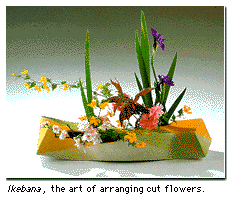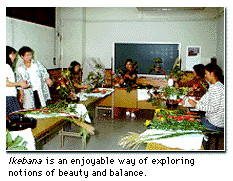 |
What is ikebana? |
 |
 Ikebana is the art of beautifully arranging cut stems, leaves, and flowers in vases and other containers that evolved in Japan over seven centuries. To arrange the stems and flowers exactly as one wishes, a familiarity with many different ways of fastening and positioning them is necessary. These techniques are what people attend ikebana classes to learn. Usually, three to five years are required to acquire these technical and expressive skills.
Ikebana is the art of beautifully arranging cut stems, leaves, and flowers in vases and other containers that evolved in Japan over seven centuries. To arrange the stems and flowers exactly as one wishes, a familiarity with many different ways of fastening and positioning them is necessary. These techniques are what people attend ikebana classes to learn. Usually, three to five years are required to acquire these technical and expressive skills.Over the seven centuries of its evolution, ikebana has developed many different styles of arrangement. Among the most common are the rikka (standing flowers), seika or shoka (living flowers), and nageire (flung flowers) styles when making arrangements in bowl-shaped vases and the moribana (piled-up flowers) style when using dish-like containers.
The main considerations in choosing what flowers to arrange and how they are decorated are the attainment of harmony between flower and container and the aesthetic blending of the flowers with their surroundings. Unlike Western styles, which tend to feature dense layers of flowers, ikebana is imbued with an Eastern view of nature, striving to achieve a rich, beautiful effect with as few stems and leaves as possible. Photos courtesy of Ohara-ryu. |
 | |
 Traditionally, arranged flowers were decorated in the toko-no-ma--the alcove in rooms where guests were normally received. Today they are also frequently seen in entrance halls and living rooms, as well as in lobbies of large buildings and shop windows.
Traditionally, arranged flowers were decorated in the toko-no-ma--the alcove in rooms where guests were normally received. Today they are also frequently seen in entrance halls and living rooms, as well as in lobbies of large buildings and shop windows.